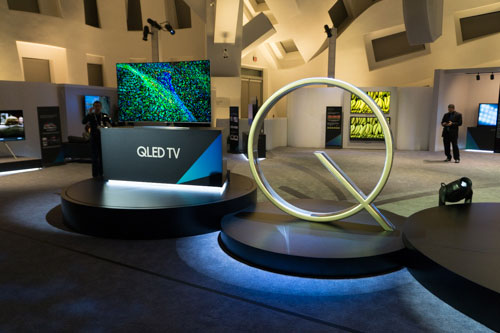Another year, another CES where Samsung introduces its latest refinements to LED LCD display technology, all while refusing to join the increasing numbers of manufacturers jumping on board with OLED. As the old saying goes, necessity is the mother of invention: given that LG Display remains the sole manufacturer of television-sized OLED panels (thanks to its ownership of the RGBW patent), and that the two companies are bitter rivals, Samsung’s need to come up with new twists on LCD is in part a matter of pride. (Pigs will fly before the company buys OLED panels from LG).

In an attempt to differentiate, Samsung is branding the new LCD variant “QLED”, and there’s a lot to like about it. A further development of Quantum Dot technology, the company promises much improved brightness (quoted at between 1500 and 2000 cd/m2), superior coverage of the DCI-P3 colour space, superior colour volume performance (meaning that colour reproduction is maintained across all brightness levels), and critically, better off-axis viewing performance, which has long been a sore point of LED LCD displays – especially Samsung’s favoured PVA type. Samsung also promises improved contrast performance at the dark end of the scale, with superior black performance rounding off the claimed improvements. As usual, we won’t be able to verify the claims scientifically until we can measure the displays ourselves, but we were impressed by what we saw at tonight’s presentation.
![]()
For eagle-eyed enthusiasts (that is, our readers), the most interesting change will be one that the company did not explicitly draw attention to in its presentations: the new displays’ subpixel rendering techniques. When viewed up close, the majority of the images shown on the QLED LCD panels did not appear with the traditional RGB stripe layout, but instead were displayed with a cross-hatch pattern. It turns out that each pixel is split into two domains, which are then driven with different gamma properties. The end result is the improvements in off-axis viewing angle quality. Samsung refers to the technique as Dual Pixel Structure.
Samsung are not the first LCD manufacturer to use such a technique – long-time HDTVTest readers will likely be thinking of Sharp’s interesting LCD panels, and even Sony’s most recent displays have employed a more subtle variant. However, both the method and the results being demonstrated by Samsung’s new QLED displays appears far more pronounced. By this, we mean the different subpixel layout is more visible, but so too are the improvements to off-axis viewing. As with those similar methods from other manufacturers, full white areas of the screen in Samsung’s QLED implementation appear as RGB stripe, with the different pixel rendering technique becoming more visible in the darker and mid tones. (One of the first tests we’ll run when we receive review samples will be to feed a gradient ramp test pattern to the screens, to better observe the different rendering techniques used at different luminance levels.)
The new method is likely to divide opinion. Users who like to sit close to the screen will probably notice the cross-hatched effect more, and in one moving test clip, bright yellow New York style taxis moving quickly up the screen appeared with a diamond-like shimmer. On the other hand, users with larger and wider rooms may decide that the off-axis viewing improvements outweigh any other disadvantages the technique may or may not bring.
Samsung’s new QLED LCDs will come in both curved and flat form factors, with exact pricing and release date information to be announced. From our brief demo, it appears that these displays represent one of the biggest re-toolings of LCD display technology in many years. The promised brightness performance will, of course, be hugely beneficial for HDR content. We’re curious to feed our usual suite of test patterns to them once we receive review samples – and now wonder if LG’s own “Nano Cell” LCD technology will follow a similar route. We’ll hopefully find out in the next few days, as the 2017 CES kicks off.